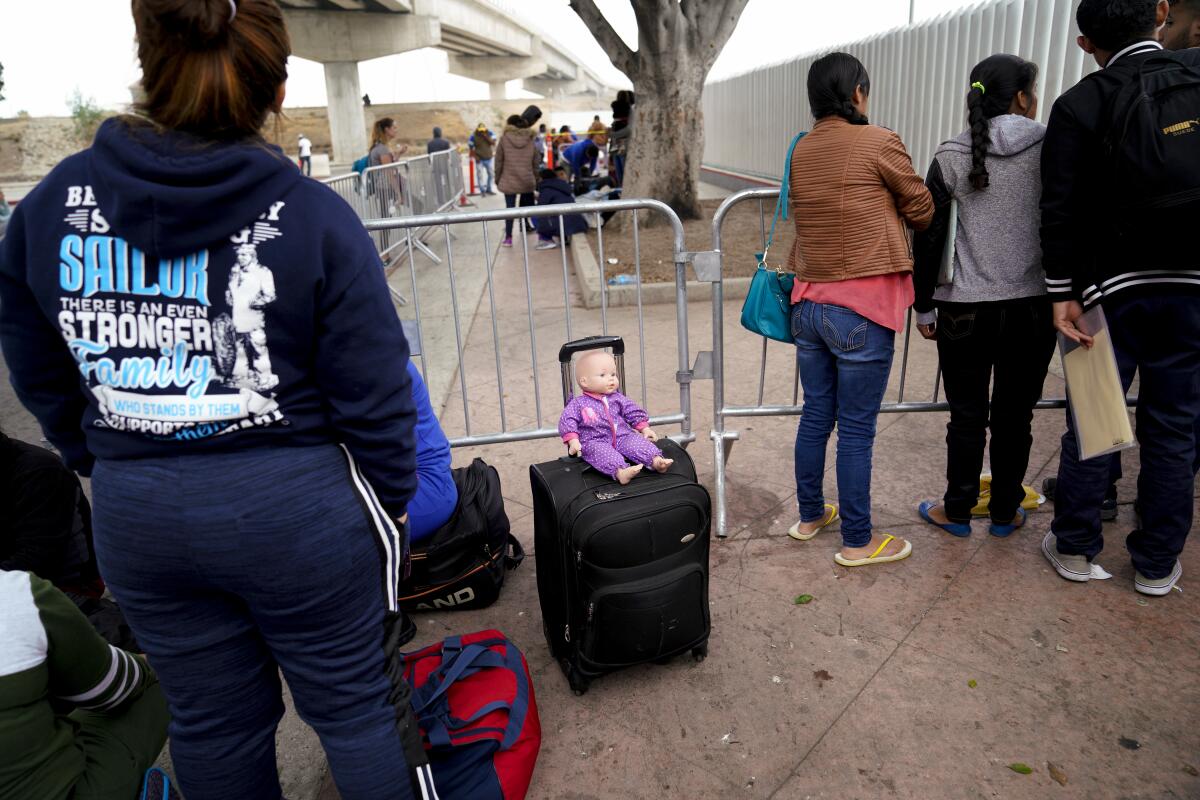Judge allows lawsuit over U.S. ‘metering’ of asylum seekers to move forward

- Share via
SAN DIEGO — A lawsuit over the federal government’s program limiting the number of asylum seekers who can ask for help at ports of entry will be allowed to go forward, a federal judge in San Diego has ruled.
U.S. District Judge Cynthia Bashant on Monday largely dismissed the government’s objections to allegations brought by legal nonprofit Al Otro Lado and a list of anonymous asylum seekers who hope to make the case a class action. The plaintiffs in the case allege that the program, called “metering” by the Trump administration, goes against the country’s obligations under U.S. and international law.
“We have seen the tragic human consequences of the turnback policy on thousands of vulnerable people who, after making a long, harrowing journey to escape their persecutors, face bullying and rejection by Customs and Border Protection officers who simply tell them to turn around and wait in very dangerous conditions,” said Erika Pinheiro, litigation and policy director of Al Otro Lado, using the lawsuit’s name for the metering program.
While metering as a practice began before Donald Trump became president — the allegations in the case go back as far as 2016 — the program has been widely used by his administration all along the U.S.-Mexico border.
The growing backlog of asylum seekers waiting to come in has put many in difficult, and sometimes dangerous, situations along the border.
In Tijuana — in addition to deportations and the “remain in Mexico” policy that returns Spanish-speaking asylum seekers from other countries to Mexico for the duration of their court cases — the long wait times for those hoping to ask for asylum put extra pressure on the city’s capacity to house migrants.
On several consecutive days at the beginning of July, U.S. officials didn’t take any people from the asylum line, causing the queue to grow to its largest yet, at about 9,150 people, according to data from Al Otro Lado, which sends volunteers daily to monitor the line’s length. Cameroonians and Eritreans waiting their turns for processing protested in response. Many said they had been forced to sleep on the street under bridges because shelters are so full.
When Nicole Ramos, an attorney with Al Otro Lado, first joined with a group of immigration and civil rights-related nonprofits to file a complaint with the Department of Homeland Security over the issue of asylum seekers being turned away at ports of entry at the beginning of 2017, officials with Customs and Border Protection dismissed those allegations, saying that the U.S. was following the law.
That complaint evolved into the current lawsuit, filed in July 2017.
The agency has often cited capacity issues as the reason it tells migrants hoping to request asylum to wait in a line in Mexico that has turned into its own de facto system subject to the authority of Mexican immigration officials. That wait has grown to several months.
The government has admitted since that it has a policy called metering, and Gisela Westwater, a lawyer for the Department of Justice, offered Judge Bashant a copy of a memo relating to the program at a hearing in May.
Westwater argued that the plaintiffs couldn’t force the agency to expend resources it doesn’t have in order to process more people. That decision, Westwater argued, is made by Congress’ budget.
“CBP is not denying that an individual may ever enter,” Westwater said. “It’s directing them to wait until CBP can process them safely and securely.”
The lawsuit contends that the capacity issues are a cover for the real reason that the Trump administration doesn’t take in more asylum seekers — deterrence. That motive would make the program illegal, the lawsuit argues.
Bashant sided with the plaintiffs, saying that the allegations they had made, if true, could very well be violating the law.
“Turning back prospective asylum applicants pursuant to an alleged executive policy that seeks to deter asylum seekers through false assertions of lack of capacity is plausibly inconsistent with and violative of the scheme Congress enacted,” Bashant wrote in her order.
As part of her reasoning, she pointed to the fact that Congress gave the president power to put a limit on the number of refugees that the United States accepts each year but not on the number of asylum seekers.
The government had also argued that some of the asylum seekers in the case could not make claims because they had not yet reached U.S. soil.
“If someone is standing at the turnstile and says, ‘I’m seeking asylum,’ are you saying the law doesn’t apply to them?” the judge asked Westwater at the May hearing.
“Yes, your honor,” Westwater responded.
Lawyers for the plaintiffs argued that their clients hadn’t been able to cross onto U.S. soil to make their requests because CBP wouldn’t let them. At the San Ysidro port of entry, there is a turnstile at the border where security guards and CBP officers check that travelers have the appropriate documents before allowing them to cross. Anyone without those documents is sent away before setting foot in the United States.
“The reason people aren’t stepping a toe into U.S. territory is the government is preventing them from doing so,” said Melissa Crow, an attorney with the Southern Poverty Law Center’s Immigrant Justice Project, on Tuesday.
Bashant ultimately rejected this objection to the case as well. The judge spent paragraphs analyzing Congress’ grammar in her 84-page order, concluding that the definition of “arriving alien,” as migrants requesting asylum at ports of entry are known in legal terms, includes those who are in the process of arriving but haven’t yet crossed the border.
The case continues to proceed in the discovery phase and will likely see filings for class certification later in the fall.
Morrissey writes for the San Diego Union-Tribune.
More to Read
Sign up for Essential California
The most important California stories and recommendations in your inbox every morning.
You may occasionally receive promotional content from the Los Angeles Times.














